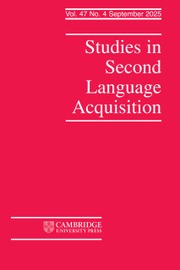Article contents
COGNITIVE APTITUDES AND L2 SPEAKING PROFICIENCY
LINKS BETWEEN LLAMA AND HI-LAB
Published online by Cambridge University Press: 09 November 2018
Abstract
This study investigated the underlying structure of a set of eight cognitive tests from the two most recent language aptitude test batteries: the LLAMA (Meara, 2005) and the Hi-LAB (Linck et al., 2013) to see whether they had any underlying constructs in common. The study also examined whether any of the observed constructs could predict L2 speaking proficiency in terms of complexity, accuracy, or fluency. Participants were 135 college-level students learning Spanish as an L2 in the United States. Results showed that the LLAMA and the Hi-LAB include tests that tap the same constructs. Specifically, the tests from the two batteries loaded onto three different factors, interpreted as “Explicit Aptitude,” “Implicit Memory Ability,” and “Implicit Learning Ability.” The results further showed that Implicit Memory Ability was a significant predictor of L2 speed fluency and interacted with Implicit Learning Ability as a predictor of lexical complexity. This finding suggested that L2 learners with greater Implicit Memory Ability may be better at accessing and retrieving previously learned or known information effortlessly. In the case of lexical complexity, the effect of Implicit Memory Ability depended on the level of Implicit Learning Ability.
- Type
- Research Article
- Information
- Copyright
- Copyright © Cambridge University Press 2018
Footnotes
This work was supported by a Spencer Foundation Small Research Grant #201500053 to Gisela Granena and Yucel Yilmaz. The authors would like to thank the Center for Advanced Study of Language (CASL) for providing us with web-delivered versions of the Hi-LAB tests and for scoring and sending us the data, blind of any specific hypothesis about the results.
References
REFERENCES
- 36
- Cited by


